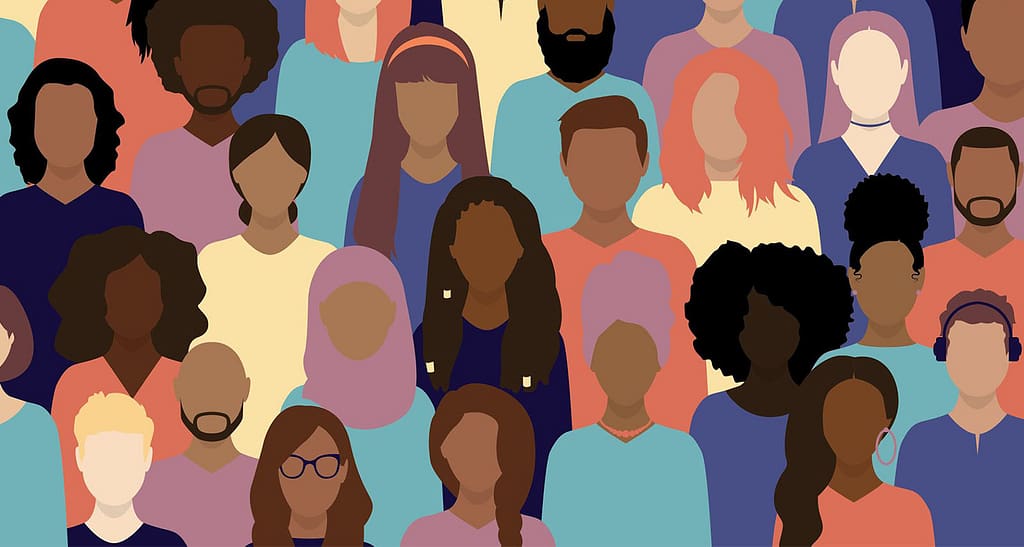
- Jacques Venter
- August 1, 2020
Facebook
Twitter
WhatsApp
Telegram
Email
What is White Privilege?
By my silence and my unwillingness to see colour, my actions will either perpetuate the false narrative of human equity that is still part of society’s narrative as shaped by those in power.

I love to go to the British Museum at least once a year and sometimes more than once, especially when we have visitors who have never been to England before. There is just something compelling and extraordinary about going to the British Museum. My favourite parts of the museum are the archaeological findings that give credence to narratives in the Bible such as the Cyrus Cylinder.
Recently, I learned that the founding collection of 71,000 pieces was bequeathed by Sir Hans Sloane, a medical doctor, collector and slave owner, upon his death in 1753. I also learned that the enormous colonnade at the entrance, completed in 1852, mimics the architecture of ancient Athens, and the neo-classical style of buildings all around the museum owes itself to the fact that at the time while the British Empire was expanding, Britain saw itself as the cultural and intellectual successors of the Greeks and Romans.
The museum holds approximately 8 million objects from every corner of the globe. All these jewels brought together like this have one obvious tale to tell. A tale constructed to remind us of Britain’s place in the world and a testament to the audacity of power.
In her book, Superior: The Return of Race Science, Angela Saini reflects on her own obsession with the British Museum and then makes this statement in the opening pages:
“When I set out to write this book, I wanted to understand the biological facts around race. What does modern scientific evidence really tell us about human variation, and what do our differences mean? I read the genetic and medical literature, I investigated the history of the scientific ideas, I interviewed some of the leading researchers in their fields. What became clear was that biology can’t answer this question, at least not fully. The key to understanding the meaning of race is understanding power. When you see how power has shaped the idea of race and continues to shape it, how it affects even the scientific facts, everything finally begins to make sense.”1
The point Saini makes is that those in power hold the pen that determines the narrative future generations will live under. Just think about the statues all over the UK that are suddenly under scrutiny, statues built over the past two centuries, memorializing individuals’ contributions to society; contributions brought about on the back of the profits of slave trading and slave owning, and a constant reminder that those in power hold the pen that determines the narrative generations will live under.
The British Museum is a collective example of this power. Consider, for example, all of the objects it holds. Why are they there and not where they were first made? Why do they live inside the museum in London with its neo-classical columns stretching into the sky? Because that’s how power works. It takes, it claims, and it keeps. It makes you believe that this is where they belong.
The global power, as it played out over the past five hundred years, meant that treasures from all over the world could and would end up in a museum like this. Britain and other European powers were the latest colonizers, the most recent winners. This imperial mindset gave us the feeling that we have the right to take things. It gave us the right to document history our way, to define the scientific facts about humankind. European thinkers told us that our cultures were better, that we were proprietors of thought and reason, and we married this with the notion that we belong to a superior race.
However, as Christians we believe that the True Narrative of humanity is something very different. We believe that Christ’s earthly life testifies of this narrative. We believe that Christ’s earthly life testifies of our loving heavenly Father who sacrificially wanted us to understand the true narrative of the worth of human beings created in His image. At every opportunity, Jesus spoke into the false narrative of human worth. And one of the most iconic biblical parables where Jesus spoke into the false narrative of human worth is found in Luke 10:30-37.
30 Then Jesus answered and said: “A certain man went down from Jerusalem to Jericho, and fell among thieves, who stripped him of his clothing, wounded him, and departed, leaving him half dead. 31 Now by chance a certain priest came down that road. And when he saw him, he passed by on the other side. 32 Likewise a Levite, when he arrived at the place, came and looked, and passed by on the other side. 33 But a certain Samaritan, as he journeyed, came where he was. And when he saw him, he had compassion. 34 So he went to him and bandaged his wounds, pouring on oil and wine; and he set him on his own animal, brought him to an inn, and took care of him. 35 On the next day, when he departed, he took out two denarii, gave them to the innkeeper, and said to him, ‘Take care of him; and whatever more you spend, when I come again, I will repay you.’ 36 So which of these three do you think was neighbour to him who fell among the thieves?” 37 And he said, “He who showed mercy on him.” Then Jesus said to him, “Go and do likewise.”
Since the killing of George Floyd this parable has been on my mind. Besides other lessons we can draw from this parable, it has impressed upon me to the following since George Floyd’s death:
Although Jesus died for our salvation, it appears what brought about his crucifixion was the way he lived for justice and human equity.
By my silence and my unwillingness to see colour, my actions will either perpetuate the false narrative of human equity that is still part of society’s narrative as shaped by those in power. Or my actions will sacrificially, like Jesus, reveal a more beautiful eternal narrative of human equity and salvation.
It is clear from Jesus’ earthly ministry that he lived out his mission, according to Isaiah 11:4 — ‘With righteousness He shall judge the poor and decide with equity for the meek of the earth’; and, according to Isaiah 61 — ‘The Lord loves justice’.
It is clear to me from this parable that Jesus was addressing the false narrative as it was shaped by those in political and religious power for centuries before. The Jews could not stand the gentiles. The term ‘gentile’ was given to any person other than a “pure” Jew. To Jews, gentiles were predestined to be lost unless they conformed to the purest and strictest rules of Judaism. Even then, there was a sense that they were less valuable to God, because they were not of the bloodline of Abraham.
Samaritans were considered to be even lower in worth than gentiles. They were a mixed race of Jewish and Syrian heritage as a result of Assyrian invasions in the sixth century before Christ. Just remind yourself of the time when James and John felt that it would have been appropriate for Jesus to call fire from heaven to consume the Samaritans.
When Jesus is therefore given the opportunity to teach his Jewish audience what human kindness looks like, he speaks into their false narrative of human equity, turns it upside down and upholds the “other than us” person as a model for human kindness.
The significance to me here is that Jesus was trying to tell them something about their Jewishness that black and other ethnic minorities are trying to tell me about my whiteness today. The intellectual Jew’s response to Jesus’ question at the end of the parable is telling of my own ignorance not too long ago. So, which of these three do you think was neighbour to him who fell among the thieves?” And he said, “He who showed mercy on him.” I’m going to give this intellectual Jew the benefit of the doubt that it was not his intention to deliberately ignore the value of the Samaritan in the parable. Yet, even when I do, it reminds me so powerfully of the time I told one of my black pastoral colleagues that I didn’t see her colour. Now I look back in horror at my ignorance for suggesting to her that I do not see her for who she really is- a beautiful, amazing person and pastor.
Just imagine what daily life must have been like for a Samaritan within the social, religious and political structures of 1st century Judaism that demonstrates systemic, institutional racism. These deeply meaningful reflections on this passage over the past few months were further informed when a good friend shared with me a video series entitle, The Wound. It describes the dilemma of systemic white privilege, something I can, from experience, confirm is definitely true. In part two of this series of videos, Dr Donn Leathermann describes the dehumanizing inequality of white privilege in the following way:
“One of the problems when we talk about white privilege is that a lot of white people feel like guilt is being thrust upon them for something. And they look at what they’re doing, and they say, “I haven’t done anything wrong. I did not hurt anybody. I did not throw any stereotypes around or any racial epithets. What are they talking about when they say white privilege? And the fact is, white privilege is a sort of invisible thing from this side. When we look at the way we are treated. Let’s say by other people in a story, by policemen, or by whoever it is, we evaluate this treatment and we say, ‘That’s just normal.’ That’s the way you’re supposed to treat people, so that I expect that the cashier in the supermarket is going to be reasonably polite to me and ring up my sale and tell me to have a nice day. I expect when the policeman stops me, he is going to write me a ticket without saying anything nasty about me, without doing anything dangerous, without shooting me. I expect to be treated normally. And the truth is, the way I’m treated is normal and that’s the point. White privilege is not about people doing something wrong. It’s about other people not being treated right. It’s the deficit in the way black people, Hispanic people, other people are treated, and we can’t really experience it. Obviously, I never had a black skin, never had a Spanish accent, never lived in a female body. I never had any experience except the one I got. And so, I never perceive somebody treating me unfairly. I’d have to be in that experience to know it. And the truth is, the kind of treatment that I get as a white person is nothing I need to be ashamed of. I have not done anything wrong. And the person who is interacting with me hasn’t done anything wrong either. We’re not breaking any laws or hurting anybody or doing anything immoral. The problem is, other people aren’t treated this way. The truth is, if you want to put it this way: There is absolutely nothing wrong with white privilege, except the fact that it is not everybody’s privilege and there’s the problem.”
Paul’s words in Galatians 3:28-29 is a reminder that Jesus spoke into the false human narrative of equity during his earthly ministry and he redressed the scales of value when he died on the cross: “There is neither Jew nor Greek, there is neither slave nor free, there is neither male nor female; for you are all one in Christ Jesus”.
The parable of the Good Samaritan has taught me over the past several months that I can either choose to act and speak like Jesus to bring about a new narrative, a more beautiful and eternal narrative of Godly equity; or I can, like the young man in this narrative, walk away and silence the struggle of human equity and salvation.
________________
Saini, Angela. (2020). Superior: The return of race science. London: Fourth Estate.

How Should Christians be Different?
September 6, 2023

The Pastoral Caregiver – Bearer of Stories
September 6, 2023

What Takes to be Different?
September 6, 2023

The Beauty of Diversity Within the Body of Christ
September 6, 2023

The Butterfly, an Object Lesson of Transformation
September 6, 2023

Mitigating the Risks of Cultural Compromises
September 6, 2023

Embracing Christ-Centered Counterculture
September 6, 2023








